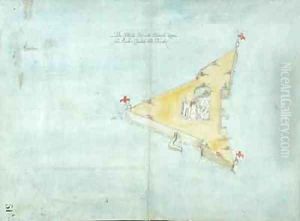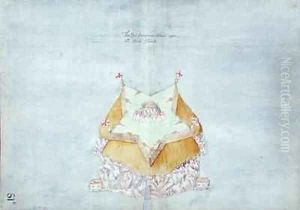Robert Devereux Paintings
Robert Devereux, 2nd Earl of Essex, was a prominent figure in the Elizabethan court, known not for his contributions to art, but for his military and political endeavors in late 16th and early 17th century England. Born on November 10, 1565, Devereux was the son of Walter Devereux, 1st Earl of Essex, and Lettice Knollys. His father's death in 1576 and his subsequent inheritance of the earldom at a young age placed him in a position of considerable influence. His mother's later secret marriage to Elizabeth I's favourite, Robert Dudley, Earl of Leicester, further complicated his position at court.
Essex's early years were marked by education and military service; he studied at Trinity College, Cambridge, and fought in the Netherlands under Sir Philip Sidney, his stepfather's nephew, against the Spanish. His charisma and ambition quickly made him a favourite of Queen Elizabeth I, and he rose rapidly in courtly circles. However, his impulsive nature and involvement in military campaigns, notably the unsuccessful 1597 Islands Voyage against the Spanish and the mismanaged 1599 campaign in Ireland as the Lord Lieutenant, tarnished his reputation.
Essex's relationship with Elizabeth I was complex and fraught with tension. Initially one of the queen's closest confidantes, his tendency to overstep the bounds of Elizabethan court politics led to periods of disfavour. His unauthorized return from Ireland in 1599 and his subsequent failure to suppress the rebellion there were seen as direct challenges to the queen's authority, leading to his eventual downfall.
In a desperate bid to restore his fortunes, Essex led a rebellion against Elizabeth in 1601. The poorly planned coup failed, and Essex was captured, tried, and executed for treason on February 25, 1601. His death marked the end of the Essex family's prominence and served as a cautionary tale of the dangers of overreaching in the volatile world of Elizabethan politics.
Though Essex's life was primarily marked by his military and political career, his legacy also includes the patronage of arts and literature, reflecting the cultural vibrancy of the Elizabethan era. He was a patron to several prominent figures of the time, including playwrights and poets, which indirectly contributed to the flourishing of English Renaissance literature and drama.

